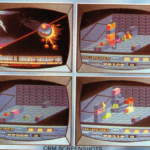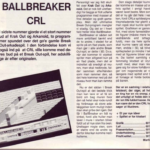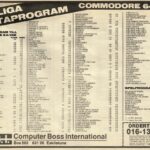Ball Breaker was an isometric breakout style of game that was released back in 1987 by CRL for the Amstrad and ZX Spectrum platforms.
What of a C64 edition though? Well, there hasn’t really been any evidence to suggest that a C64 version was on the cards – however, contributor Martin Smith found that the released cover seems to show “CBM” screenshots on the back.
What is particularly odd though is that the screenshots don’t look particularly C64-like – there are too many colours not present in the palette. It’s not the CPC version either, as the colours are not vibrant enough, and again seems to be consisting of colours not in the CPC palette.
So was it perhaps a 16-bit version being shown that was also unreleased? Might have been too early for CRL to do a 16-bit title. One theory is that CRL may have got hold of an Amiga very early on, and mock up screenshots were produced on the platform. However, there are subtle changes occurring in each of the screens – suggesting they were taken from something that was running.
Graeme Mason has done an in depth feature on Ball Breaker, and mentions the possibility of a C64 edition. It is suggested that the C64 would have been too slow to have handled a conversion, hence no conversion was made. There is no suggestion though if a conversion was started, but it is possible that something was started to test the water and viability.
Carlo Pirri (DrBong/Hall of Light team) got in touch after doing some research into another CRL game and found that Ballbreaker was later tidied up and converted to the ST/Amiga and released as Transputor in 1988. The artist for this conversion is credited as Jon Law, who likely would have been behind the C64 edition. So a lead to check!
Carlo agrees that screenshots are far too colourful to be C64 based, so it is felt that they were likely mock ups, possibly produced on the Atari ST with Degas, and then perhaps colour reduce for a C64 conversion later.
Interestingly, a C64 edition was apparently reviewed in Danish magazine RUN, back in June 1987. Was this really a C64 game reviewed, or did RUN magazine fake a review, anticipating a C64 version was coming?
Anonymous contributor (who has some amazing findings below!) also found mentions in Swedish mag Datormagazin, Oct 1987, page 15, says the following (most of the text that follows is direct from them):
“Tau Ceti may not have been that great on the 64, but CRL has a lot of hopes for the Amiga version. CRL will also release the first three-dimensional Breakout game for the 64 called Ball Breaker, but this game will not appear on the Amiga.”
As Anonymous contributor notes, its a bit odd – as the Amiga version actually came out. Then in the earlier May 1987 issue of Datormagazin, page 11, the game “Ballbreaker” is advertised as for sale for the Commodore 64 (see scans).
Then even earlier, German magazine Aktueller Software Markt Feb 1987, page 53 has this to say:
“As you can see in the photo, CRL is trying to achieve a “resounding” success with its BALL BREAKER! The game is already on the market, initially available for Schneider and will cost about 30 marks (cass) or 45 marks (disk). The Spectrum and C-64 versions are expected in April. The player controls a kind of bat that causes a ball to thunder against a wall with force.
You now have to tear down the wall completely to get to the next level. Different colored bricks complicate the project: Some cause your ball to bounce back uncontrollably, which can cause the ball to burst. Also, there are some “small, nice” monsters behind the wall that you should kill…”
This makes it highly likely that CRL had actually advertised a C64 version in a press release.
As stated earlier – Danish mag IC RUN June/July 1987, page 38, featured a review of Ball Breaker. Since the mag was Commodore only, this implied that the version reviewed was for a CBM computer. There are a number of odd discrepancies, though:
- The review does not say exactly what machine. Instead, it is a rather general review of the game.
- No mention of any cass/disk price, which would be standard for IC Run.
The most telling discrepancy however, is the screenshot. It is very similar to a screenshot also seen in the mag Computer and Videogames, July 1987, page 36 in a review of the Amstrad version:
https://archive.org/details/c-
The shot is from level 1 of the Amstrad version. See it here:
https://www.youtube.com/watch?
Comparing the CVG screenshot with the Danish shot, the following similarities appear:
- Dashboard is exactly the same, with 200 points score and 10 missiles left
- The curved corners of the shot is at the same CRT screen angle
- The bat is placed at exactly the same floor notch
- The top level of bricks features 4 blocks (i.e. Amstrad level 1). BUT, in the Danish version the 2nd on the left is falling, as if having had its base level hit by the ball. So, this is probably a later shot of the same event. In fact, you can see almost the same scene at 0:12 in the YT video above. And everything matches up with the Amstrad version. The Spectrum level 1, for comparison, has different blocks placed on top.
Everything points to the Danish review showing an Amstrad screenshot – perhaps even a press release shot, since it is so similar to the CVG one. The journalist may have played the Amstrad version, or just collated a number of independent reviews.
So, what about the C64 screenshots on the box? Our entry has shots from the Amstrad box:
https://www.mobygames.com/
In comparison, the Spectrum box shots are darker and clearer:
https://www.mobygames.com/
It is very likely the “CBM” shots are also of the Amstrad version, as suggested in the post:
- The colours could be explained by the screenshots being from a blurry CRT, then printed on the back of cheap paper and left to fade for 35+ years.
- The dashboard is identical to the Amstrad version, complete with hints of colour-cycling of the texts and all.
What do differ, however, are the back walls. They are much higher in the screenshots than in the final Amstrad game. Also, there is a big diamond on the left-hand wall, which is gone from the final Amstrad version.
Where did all that go, if these are Amstrad screenshots? Perhaps these are shots from an earlier development version, i.e. Amstrad Ball Breaker V1. Since there were plans for a C64 version, but none was yet present, early Amstrad images were used to create the illusion of a different version for a different platform.
But why advertise a CBM version on the back of the Spectrum and Amstrad box? Printing mistake, perhaps, and then it was too late and costly to change.
Actually, the high back walls and, occasionally, the diamond (of sorts), are still there in the Spectrum version, indicating perhaps that they were design details stemming out of the original Amstrad design.
Hopefully we will find out more soon to clarify, and also figure out exactly where the screenshots come from. If you know anything more to add to the above, please get in touch.
Contributions: Martin Smith, Stone Oakvalley (Magazine scan search), Carlo Pirri, Anonymous Contributor



